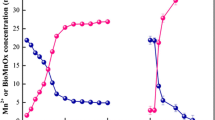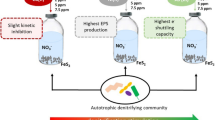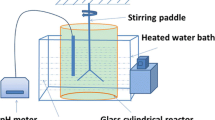Abstract
Manganese biogeochemistry holds special interest for the characterization of passive treatment systems designed to treat acidic mine waters while meeting enforceable effluent discharge limits set for manganese. In the present study, an initial anoxic enrichment culture was developed for use as an inoculum in experimental systems. Standard anoxic microcosms capable of reducing manganese from Mn4+ to Mn2+ were established from the initial enrichment and altered to study the effects of electron acceptor availability and inhibitors on manganese reduction. Manganese reduction was not significantly inhibited in aerobic and nitrate amended microcosms; however, systems amended with metabolic inhibitors (sodium azide or sodium molybdate) exhibited significant inhibition of manganese reduction relative to standard microcosms. The presence of iron was found to influence the partitioning of reduced manganese with adsorption becoming more important with increasing iron to manganese ratios.
Similar content being viewed by others
References
Aller, R.C. and P.D. Rude, 1988. Complete Oxidation of Solid Phase Sulfides by Manganese and Bacteria in Anoxic Marine Sediments. Geochimica. Cosmochimica. Acta, 52: 751–765.
Arakaki, T. and J.W. Morse, 1993. Coprecipitation and Adsorption of Mn(II) with Mackinawite (FeS) under Conditions Similar to those Found in Anoxic Sediments. Geochimica. Cosmochimica. Acta, 57: 9–14.
Balistrieri, L.S. and J.W. Murray, 1982. The Surface Chemistry of δMnO2 in Major Ion Seawater. Geochimica. Cosmochimica. Acta, 57: 9–14.
Burdige, D.J. and K.H. Nealson. 1986. Chemical and Microbiological Studies of Sulfide-Mediated Manganese Reduction. Geomicrobiology Journal, 4: 361–387.
Burdige, D.J., S.P. Dhakar and K.H. Nealson, 1992. Effects of Manganese Oxide Mineralogy on Microbial and Chemical Manganese Reduction. Geomicrobiology Journal, 10:27–48.
Christensen, B., L. Morten and T. Lien, 1996. Treatment of Acidic Mine Water by Sulfate-Reducing Bacteria; Results from a Bench Scale Experiment. Water Research, 30:1.
De Vrind, J.P.M., F.C. Boogerd and E.W. De Vrind-De Jong, 1986. Manganese Reduction by a MarineBacillus Species. Journal of Bacteriology, 167: 30–34.
Ehrlich, H.L., 1996. Geomicrobiology. Marcel Dekker, Inc., NY.
Ehrlich, H.L. 1987. Manganese Oxide Reduction as a Form of Anaerobic Respiration. Geomicrobiology Journal, 5:423–431.
Ghiorse, W.C. 1988. Microbial Reduction of Manganese and Iron. In: A.J.B. Zehnder (Editor) Biology of Anaerobic Microorganisms. John Wiley and Sons, N.Y. pp. 305–331.
Ghiorse, W.C. and H.L. Ehrlich, 1976. Electron Transport Components of the MnO2 Reductase System and the Location of the Terminal Reductase in a MarineBacillus. Applied and Environmental Microbiology, 31:977–985.
Lovley, D.R., 1991. Dissimilatory Fe(III) and Mn(IV) Reduction. Microbiological Reviews, 55:259–287.
Lovley, D.R. and E.J.P. Phillips, 1988. Novel Mode of Microbial Energy Metabolism: Organic Carbon Oxidation Coupled to Dissimilatory Reduction of Iron and Manganese. Applied and Environmental Microbiology, 54: 1472–1480.
Machemer, S.D. and T.R. Wildeman, 1992. Adsorption Compared with Sulfide Precipitation as Metal Removal Processes from Acid Mine Drainage in a Constructed Wetland. Journal of Contaminant Hydrology, 9: 115–131.
Myers, C.R. and K.H. Nealson, 1988. Bacterial Manganese Reduction and Growth with Manganese Oxide as the Sole Electron Acceptor. Science, 240: 1319–1321.
Nealson, K.H. and C.R. Myers, 1992. Microbial Reduction of Manganese and Iron: New Approaches to Carbon Cycling. Applied and Environmental Microbiology, 58: 439–443.
Phillips, P., J. Bender, R. Simms, S. Rodriquez-Eaton and C. Britt, 1995. Manganese Removal from Acid Coal-Mine Drainage by a Pond Containing Green Algae and Microbial Mat. Water Science and Technology, 31: 12: 161–170.
Postgate, J.R. (ed.), 1984. The Sulfate Reducing Bacteria. 2nd ed. Cambridge University Press, Cambridge.
Stark, L.R., F.M. Williams, W.R. Wenerick, P.J. Wuest and C. Urban, 1996. The Effects of Substrate Type, Surface Water Depth, and Flow Rate on Manganese Retention in Mesocosm Wetlands. Journal of Environmental Quality, 25: 97–106.
Sung, W. and J.J. Morgan, 1981. Oxidative Removal of Mn(II) From Solution Catalyzed by the γ-FeOOH (Lepidocrocite) Surface. Geochimica Cosmochimica Acta, 45: 2377–2383.
Tarutis, W.J., Jr. and R.F. Unz, 1996. Biogeochemical Fate of Coal Mine Drainage Pollutants in Constructed Wetlands. Current Topics in Wetland Biogeochemistry, 2: 40–51.
Tarutis, W.J., R.F. Unz and R.P. Brooks, 1992. Behavior of Sedimentary Fe and Mn in a Natural Wetland Receiving Acidic Mine Drainage, Pennsylvania, U.S.A. Applied Geochemistry, 7: 77–85.
Thornton, 1995. Manganese Removal from Water using Limestone-Filled Tanks. Ecological Engineering, 4: 11–18.
Weider, R.K., 1989. A Survey of Constructed Wetlands for Acid Coal Mine Drainage Treatment in the Eastern United States. Wetlands, 9: 299–315.
Weider, R.K. and G.E. Lang, 1986. Fe, Al, Mn, and S Chemistry ofSphagnum Peat in Four Peatlands with Different Metal and Sulfur Input. Water, Air, and Soil Pollution, 29: 309–320.
Weider, R.K., M.N. Linton and K.P. Heston, 1990. Laboratory Mesocosm Studies of Fe, Al, Mn, Ca, and Mg, Dynamics in Wetlands Exposed to Synthetic Acid Coal Mine Drainage. Water, Air, and Soil Pollution, 51: 181–196.
Wildeman, T.R., D.M. Updegraff, J.S. Reynolds and J.L. Bolis, 1994. Passive Bioremediation of Metals from Water Using Reactors or Constructed Wetlands. In: J.L. Means and R.E. Hinchee. (Editors), Emerging Technology for Bioremediation of Metals. Lewis Publishers, Ann Arbor, MI, pp. 13–24.
Zehnder, A.J.B. and W. Stumm, 1988. Geochemistry and Biogeochemistry of Anaerobic Habitats, In: A.J.B. Zehnder (Editor) Biology of Anaerobic Microorganisms. John Wiley and Sons, N.Y. pp. 1–38.
Author information
Authors and Affiliations
Rights and permissions
About this article
Cite this article
Royer, R.A., Unz, R.F. Manganese oxide reduction in laboratory microcosms. Mine Water and the Environment 18, 15–28 (1999). https://doi.org/10.1007/BF02687247
Issue Date:
DOI: https://doi.org/10.1007/BF02687247




